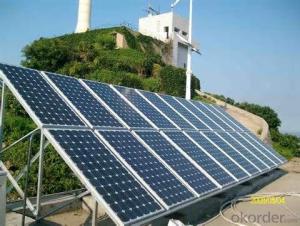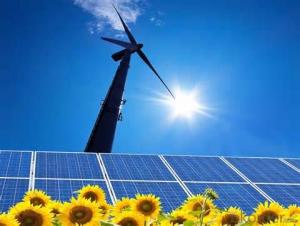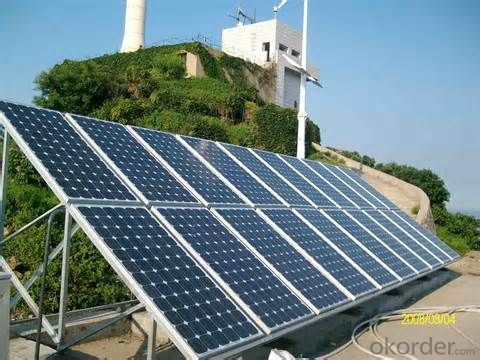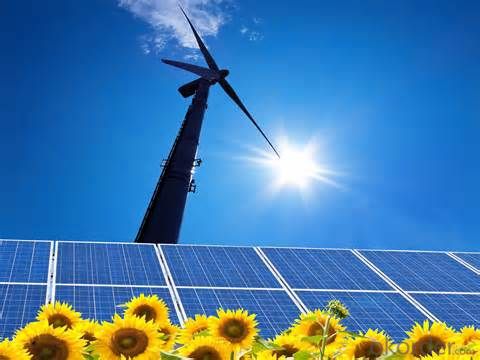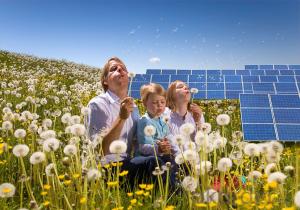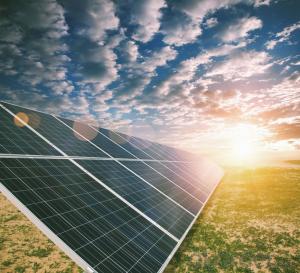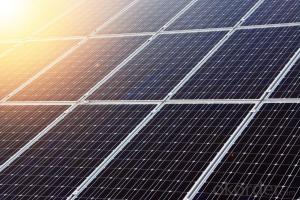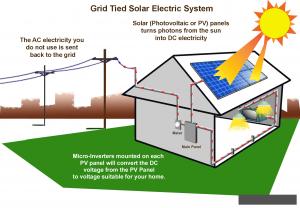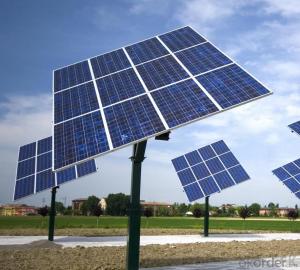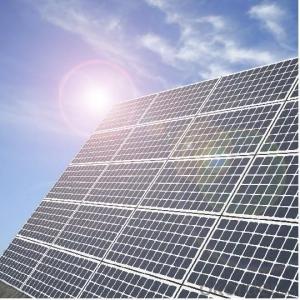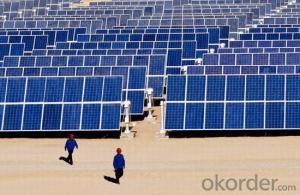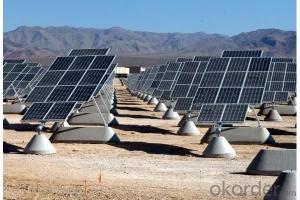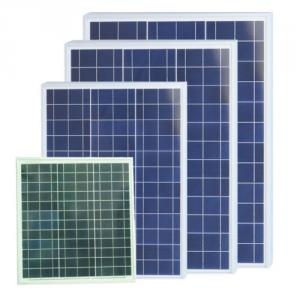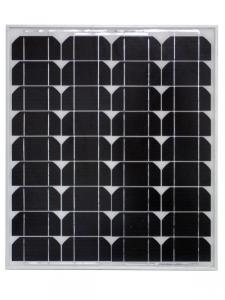Solar Panels Temecula - High Efficiency Polycrystalline Solar Panels 20w to 50w
- Loading Port:
- China main port
- Payment Terms:
- TT OR LC
- Min Order Qty:
- 1000 watt
- Supply Capability:
- 1000000 watt/month
OKorder Service Pledge
OKorder Financial Service
You Might Also Like
Specification
Introduction of Poly solar panels CNBM
Polycrystalline Solar Panels 20W 50W With High Efficiency
CNBM Solar photovoltaic (PV) Panel is designed for large electrical power requirements. It is the optimal choice for both on-grid and off-grid power systems. CNBM Solar panel offers high performance of power per square foot of solar array. Monocrystalline silicon(c-Si): often made using the Czochralski process. Single-crystal wafer cells tend to be expensive, and because they are cut from cylindrical ingots, do not completely cover a square solar cell module without a substantial waste of refined silicon. Hence most c-Si panels have uncovered gaps at the four corners of the cells.
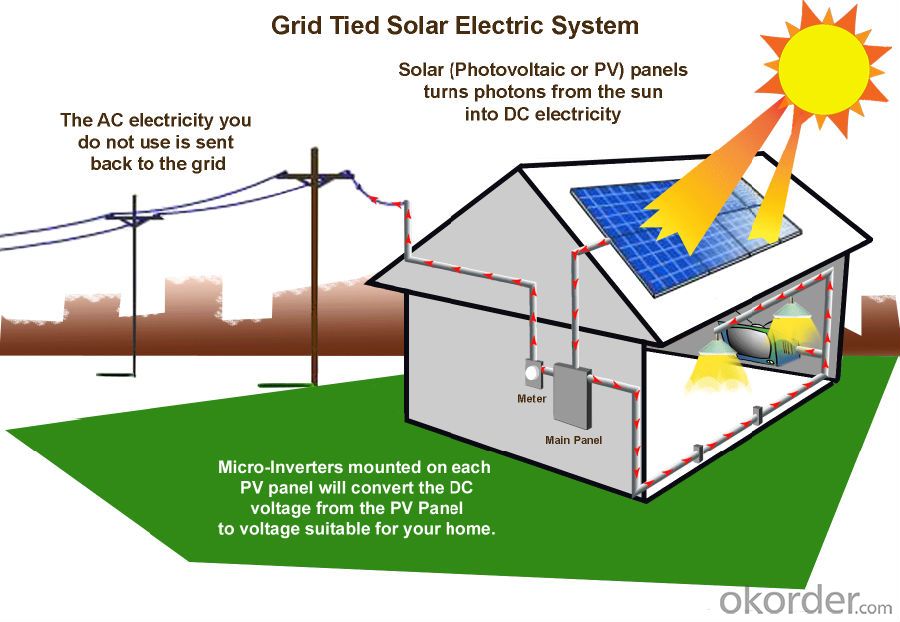
Feature
1.Solar Cell : High efficiency crystalline solar cell. Even if under the weak light, the solar module can produce maximum power output.
2.Tempered glass (toughened glass): Anti-reflecting coating and high transmission rate glass increase the power output and mechanical strength of solar module.
3.EVA and TPT: Using high quality EVA and TPT to prevent destroying and water.
4.Long lifetime: ≥25 years; Less power decrease.
5.Resisting moisture and etching effectively, not effected by geology.
6.The certificate issued by international authority: UL, TUV, IEC, VDE, CE.
Main Solar Panel Specification
Characteristics of Poly solar panels CNBM | |||||
Max Power Voltage Vmp(V) | 30.3 | 30.8 | 31.1 | 31.4 | 31.85 |
Max Power Current Imp(A) | 7.60 | 7.64 | 7.73 | 7.81 | 7.85 |
Open Circuit Voltage Voc(V) | 36.1 | 36.6 | 37 | 37.3 | 37.68 |
Short Circuit Current Isc(A) | 8.50 | 8.55 | 8.65 | 8.75 | 8.85 |
Max Power Pm(W) | 230W | 235W | 240W | 245W | 250W |
Temperature Coefficient of Cells Poly solar panels CNBM | |
NOCT | 45℃ ± 2℃ |
Temperature Coeffucients of Isc (%/℃) | 0.0492 |
Temperature Coeffucients of Voc (%/℃) | -0.3374 |
Temperature Coeffucients of Voc (%/℃) | -0.4677 |
Mechanical Data of Poly solar panels CNBM | |
Dimension | 1638 × 982 × 40 mm |
Weight | 19.5 kg |
No. of Cells and Connections | 60 (6 ×10) |
Tolerance | 0 ~ + 5 W |
Cell | Monocrystalline Cell 156 × 156 mm |
Packing | 624 Pcs/40ft(H) Container |
Limits of Poly solar panels CNBM | |
Operating Temperature | -40℃ to +85℃ |
Storage Temperature | -40℃ to +85℃ |
Max System Voltage | 1000VDC(IEC) / 600VDC(UL) |
Guarantees of Poly solar panels CNBM | |
Products Guarantee | 12 yrs free from defects in materials and workmanship |
Performance Guarantee | No less than 90% within 10yrs and no less than 80% within 25yrs |
Certificates | TUV(IEC61215&IEC61730),VDE(IEC61215&IEC61730),UL,CE |
Packaging Information
Package:26pcs/box
Quantity:1 box/pallent
Loading Capacity:952pcs/40ft
- Q: solar panel capacity, how do it work
- You can find a lot on the Internet about how solar panels work. See the links below. I'm not sure how you define capacity. Solar panels are made up of many solar cells. Each cell is capable of generating a low DC voltage while delivering a small current, Several cells are connected in series, making strings to develop the required voltage. Then many of these strings are connected in parallel, so the panel can deliver a usable current. Then the panels are connected in series and/or parallel to deliver a usable voltage and current. My panels are rated at 24 volts. 20 panels are connected in series to develop 480 volts. This is sent to an inverter, which converts the 480 volts DC to 20 volts AC
- Q: solar panels!!they are fantastic! cause they are the new way of quot;chargingyour home, without killing the earth!would you install them, or not? and make sure you say WHY
- If your house was not built to include solar panels, it may encounter problems that most people do not consider. For example, your neighbor may plant trees nearby and they could shade your panels. Your house may not have good alignment with the sun, so your net hours of sunshine may be too small. If your local planning folks allow panels and your house is oriented properly to the sun and no trees will block the sun, I suspect it will be a good investment long term. Still the up front cost is high. I feel that common folk like myself would be better served if we could buy shares in our local power company by purchasing a number of panels ... offered and installed by them ... and that we would then get a net monitoring of both our own electrical use and a reduction on our electric bill for the portion of our investment. That way, it seems we could each make a small investment in solar and add to that investment as we earn more money ... and essentially eliminate the need for new centralized power plants. How many malls does your city have that are completely empty and could be returned to the community as a mini power plant site. My city is loaded with malls that nobody uses anymore. Businesses move and and fail because nobody goes there. They go to the new more sexy malls. Several of these outdated malls have power lines running directly through their empty parking lots. Why not have community solar investments in these sites? Every building could include solar panels and the entire parking lot could be covered with panels. The inside of the building could still be used for other routine purposes. The local power company would be the perfect organizer and maintainer. This way solar would not be so expensive. The cost would be shared by many and so would the rewards.
- Q: My mom's house has some solar power panels on the top of her house but they are not connected to anything. They don't even have wires or anything like that. Does anyone know how to connect and make solar panels work? Thank You
- They may be connected and running, but you just can't see the cables because they are concealed. Of they may not even be electric. They may be solar water heaters that have water lines running inside a black box. Did your mom purchase the house with them on there? If so, can she contact the previous owner to learn who installed them and why? In the absence of any meaningful information, I would suggest that you call a solar company in your area and have them come out to tell you what it is that you have.
- Q: How do solar panels impact the electrical grid?
- Solar panels can have a positive impact on the electrical grid by generating clean and renewable energy. When connected to the grid, they can contribute to reducing the overall demand for electricity, especially during peak times. However, their intermittent nature and fluctuating output require grid operators to carefully manage the variability to ensure grid stability. Additionally, solar panels can decentralize power generation, leading to a more resilient grid and potentially reducing transmission losses.
- Q: Can solar panels be used in disaster relief efforts?
- Yes, solar panels can be used in disaster relief efforts. Solar panels provide a reliable and sustainable source of electricity, which is crucial during times of disaster when traditional power grids may be disrupted. They can be used to power essential equipment, lighting, and communication systems in disaster-stricken areas, enabling emergency response efforts, medical services, and providing support to affected communities. Additionally, solar panels can be easily transported and set up in temporary shelters or mobile units, making them an efficient and versatile solution for disaster relief operations.
- Q: What is the impact of dust and dirt on solar panels' efficiency?
- Dust and dirt can significantly impact the efficiency of solar panels. When a layer of dust accumulates on the surface of the panels, it reduces the amount of sunlight reaching the solar cells, thereby reducing their ability to convert sunlight into electricity. This decrease in efficiency can range from a few percentage points to even as much as 20% in extreme cases. Therefore, regular cleaning and maintenance of solar panels are essential to maintain their optimal performance and maximize energy production.
- Q: 3.8 volts is required to fully charge a battery. But at 3.8 volts, the battery can be overcharged without the use of a controller correct? What if I don't care if the battery is fully charged? In the case of our family boat, I just installed a new radio, so I'm a little worried about power consumption. So now for the real question; If I hook a 2 volt panel to the batteries, do I need to worry about overcharging them? Or will the batteries stop the charging process once they reach 2 volt?I built the panel myself, it's 8 volts at 3.5 amps open circuit. I have tabs at every 3 volt increment on the panel so that I can use less voltage than 8 if I want to power something directly, (ex:2 volt radio)So I'm using the 2 volt tab at 3.5 amps(approx) for a total of approx 48 watts
- can I use a 2volt .5 amp solar panel on a 2 volt battery in a boat that i use for trolling motor and if I can can I leave it hooked up when using the trolling motor ? Plus how long would it take to charge a half drain battery with this panel??
- Q: Can solar panels be installed in a shaded area?
- Solar panels can be installed in shaded areas, but their efficiency and power output may be significantly reduced. Direct sunlight is necessary for optimal performance, so shaded areas may not provide the same energy generation as panels in direct sunlight.
- Q: This is for my science project and i cannot figure it outWe assumed that blue light shining on a solar panel would give off the higher volt reading because it has the shortest wavelength and the highest energy, but it was actually the lowest. Why does this happen? Im very confused And cant find the answer anywhere.... ,thank you!!
- It is based on what the solar panel is made out of. Many of them will generate electric into the NIR region.
- Q: but is that per day, per hour or minute?How much watts does the average AC unit use?How much does an energy efficient lightbulb use?All in all let's hypothetically say we no longer use the electric company for our energy source, How many of these panels do you estimate it would take to supply our small home?
- It's virtually impossible to estimate how many panels would be required, without knowing your electrical usage, and where the house is located. I'll give our house as an example, but it could be off by a factor of 0 (not kidding) from yours. We have gas heat, no air conditioning, and no pool. We live in a dry, sunny area of California, and our roof is ideally oriented for panels. We would need 25 such panels, but we are grid-tied. If we wanted to disconnect completely from the electric company, we would need 20% more panels to compensate for battery inefficiencies. So, the estimate is 30 panels. Here are some caveats: ) Air conditioning, especially central air, could double or triple the estimate. 2) An area that gets less sun per year (northern US, for example) would need more panels. 3) Typically, when a house has grid electricity, they keep grid electricity when they get solar panels. It's much cheaper to use both in tandem. 4) That's a horrible price for the panel in the picture. You can find a 200-watt panel for less than that. 5) Other equipment is required besides the panels to run your house off solar. You can read up on it on the internet, or ask a professional solar installer for a free quote.
Send your message to us
Solar Panels Temecula - High Efficiency Polycrystalline Solar Panels 20w to 50w
- Loading Port:
- China main port
- Payment Terms:
- TT OR LC
- Min Order Qty:
- 1000 watt
- Supply Capability:
- 1000000 watt/month
OKorder Service Pledge
OKorder Financial Service
Similar products
Hot products
Hot Searches
Related keywords
